Cow depreciation has been a frequent topic of discussion in magazines, social media and ranch management workshops for the last few years. Consultants and university experts have come up with a new idea – increase profitability with the goal of minimizing cow depreciation. I have read the articles and listened to the presentations, and I have spent a lot of time pondering the practicality and profitability of this system. So far, I have come to two conclusions:
1. The “minimize-cow-depreciation” management strategy is really a “capture-cow-and-heifer-appreciation” strategy. The goal is not to minimize depreciation (the reduction in value as a cow gets older). The real goal is to capture appreciation by adding value to your heifer calves. The plan is to breed them, have them raise two or three calves, then sell them as good running-age bred cows before they begin to depreciate too much.
2. Maybe ranchers know something consultants and university people do not know. If this is such a profitable management strategy, why are none of my neighbors and friends selling all their 5-year-old cows every year? Today’s ranchers are smart businessmen and women. If there is a way to increase profit, they already have, or soon will, discover it.
In the remainder of this article, we are going to crunch the numbers. We will get down to the details of implementing this management strategy and if it is more profitable than the typical cow-calf operation.
First, Figure 1 illustrates the value, appreciation and depreciation of a typical heifer or cow.
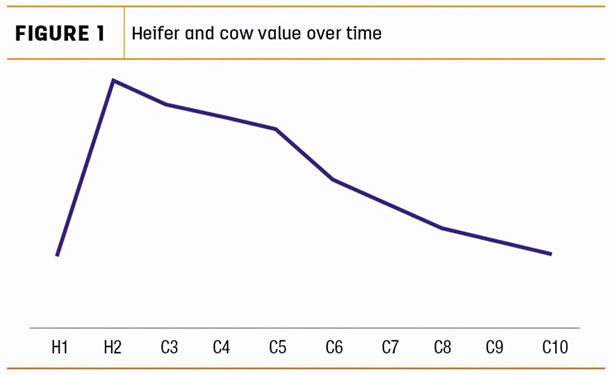
The heifer appreciates through weaning, breeding and calving. Then she begins to depreciate as she gets older, but not much until she is 4 or 5 years old (C4 and C5). After that, she will lose value more rapidly until her value levels off near salvage/cull cow value. The values might be different between operations, but they likely follow a similar pattern.
Second, Figure 2 shows the age of a typical herd in a cow-calf operation. If you add up the bars, they will equal 100%.
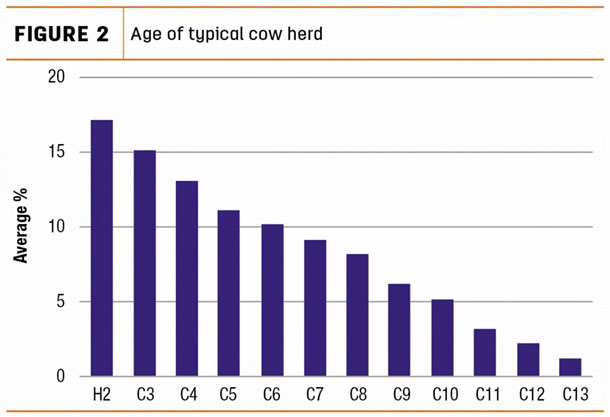
About 17% of the herd is made up of first-calf heifers (H2). About 11% of the herd is 10 years old or older (C10-C13). More than half, or 56%, of the herd is younger than 5 years old (C5). This base is important to understand because after we implement our new “capture-cow-appreciation” management system, our herd will look much different.
To make comparisons simple, we will call the base cow-calf operation the 1X Ranch and the capture-cow-appreciation strategy the 2X Ranch. It is important to remember that we are keeping ranch resources the same for comparison purposes. We do not lease more pasture or make any adjustments to fixed assets. We will need to purchase a little more hay and labor with the new system. Figure 3 illustrates the composition of the cow herds on the 1X and 2X Ranches. As you can see, the 2X Ranch is running a lot of bred and first-calf heifers.
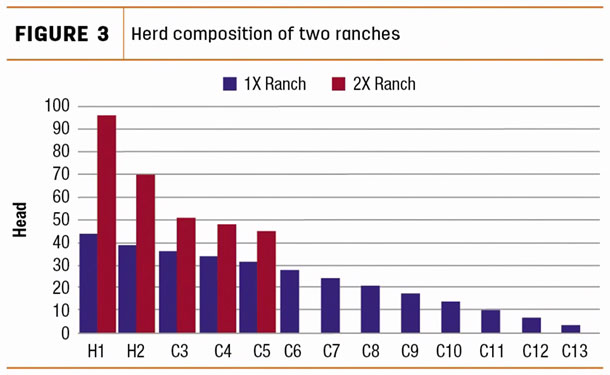
1X Ranch background
We are going to use a typical Idaho cow-calf operation as our base ranch. This is a 250-cow operation, which retains 43 heifer calves a year to breed as replacements. The 1X Ranch calves from mid-February through mid-April. Cattle are run on federal and state range from May to September. In the fall, cattle are on private pasture or crop aftermath from October through November. Calves are weaned in late October or early November. The steer calves and remaining heifer calves are sold.
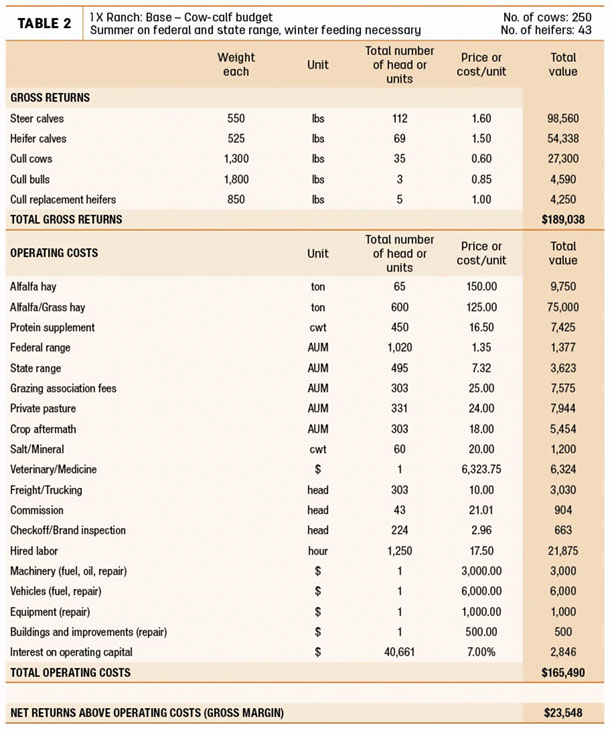
2X Ranch background
The goal of the 2X Ranch is to capture heifer and cow appreciation. Here are the main changes:
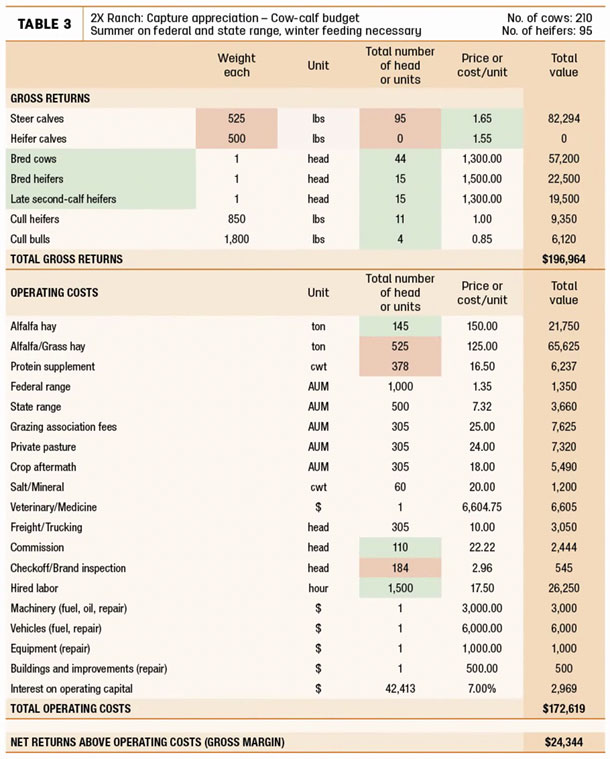
- The ranch can only run 210 cows on the same pasture.
- The ranch retains or purchases 95 heifer calves (H1s) to breed for replacements.
- The management strategy results in a very young cow herd, which presents some advantages and disadvantages.
- There are no cows over 6 years old.
- One-third of the herd is now made up of first-calf heifers each year.
- The larger percentage of first-calf heifers pulls down average calf weight by 25 pounds.
- Calving labor is increased due to the number of first-calf heifers.
- More alfalfa hay will need to be fed to developing heifers, but less grass hay will need to be fed to older cows.
- The higher percentage of heifers presents a greater challenge of getting all those second-calf heifers to rebreed on time.
- Approximately 15 late-bred second-calf heifers are sold each year.
- The ranch sells 44 bred cows each year (5-and-a-half-year-olds).
- The ranch will still have some cull cows to sell because they are open or have other issues, but not as many as the typical ranch.
- The ranch can sell approximately 15 bred heifers each year, in addition to the ones they retain.
- The ranch also has the option of purchasing replacement heifer calves and selling all or part of the heifer calf crop.
Table 1 illustrates the main differences in the ranch management systems.
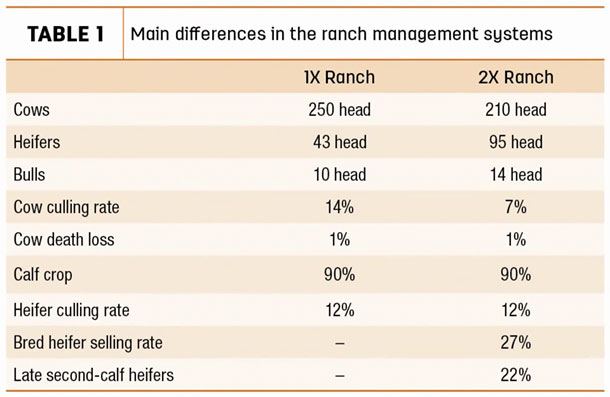
Now we get down to the real work of crunching numbers. The 1X Ranch and 2X Ranch enterprise budgets show gross returns, operating expenses and gross margin for each management strategy. The fixed/overhead costs are left out of this comparison to keep it simple. Those costs would not change significantly – at least not in the short run. In the 2X Ranch budget, numbers highlighted in pink decreased, while numbers highlighted in green increased, in comparison to the 1X Ranch budget.
Budget comparison
Comparing the profitability of each management system on paper is not the same as implementing it in real life, but it is the first step. Based on our assumptions, the 2X Ranch has a slightly higher gross margin than the 1X Ranch. The difference is about $800. This might have something to do with the number of ranches that have implemented this management system.
Other considerations
There are pros and cons for each system, besides the bottom line. Here are some aspects to consider before making a change:
- Can you efficiently market bred cows? If you have a reputation for raising good cattle, you will have an advantage when it comes to selling females.
- What stage of the cattle price cycle are we in? Timing the price cycle correctly could make the 2X Ranch system very profitable.
- How will the change affect your net worth? The 2X Ranch management system could increase equity in your cow herd by $30,000 or more.
- Are there ways you can reduce heifer development costs?
- Do you have the facilities and extra labor to calve out more heifers? One-third of the herd will be first-calf heifers.
- Death loss for calves and first-calf heifers could likely be higher than the numbers we used in our assumptions.
- Would it be more profitable to purchase heifer calves rather than retain your own? Depending on your feed costs and sources for good heifers, this might be the thing to do. In addition, you could then use terminal/growth sires on your mature cows and put some extra pounds on those calves.
- Would it be more profitable to purchase bred heifers and run more cows and fewer heifer calves? Put together a heifer development budget and see if you can raise them cheaper than your neighbor can sell them to you for.
- Are there tax advantages for selling breeding livestock versus calves? Calf sales income is taxed as ordinary income, while profit from selling breeding livestock is taxed as capital gains income. Depending on your tax bracket, the capital gains tax rate could be half as much as the tax rate for ordinary income.
Conclusion
No matter how you look at it, profit margins in the cow-calf business are tough to increase. Perhaps capturing cow appreciation could be a profitable management system for your ranch. There is no silver-bullet ranch management system. Nevertheless, crunching your own numbers and weighing the pros and cons of any alternative can improve your chances of making profitable decisions.







